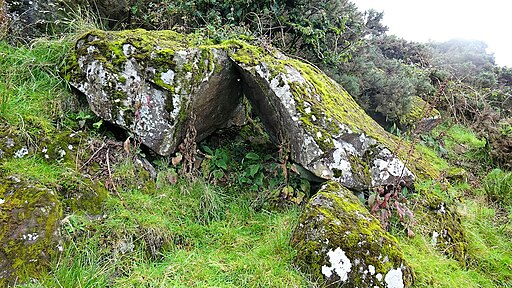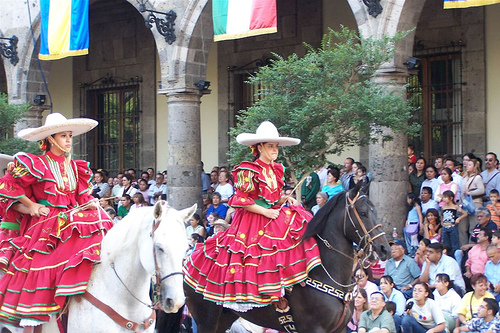
This mask was worn as a disguise by the outlawed Covenanting minister Alexander Peden (1626 – 1686). He was also known as “Prophet Peden” and was one of the leading figures in the Covenanter movement in Scotland.
The Covenanters were a Scottish Presbyterian movement that refused to accept the King as the spiritual head of the church in Scotland.
They believed that Jesus Christ was the head of the church. They also rejected the traditional church hierarchy, which was ruled by bishops. They thought that their congregations should choose ministers.
For Charles I, this attitude was treasonous, and he declared war on the Covenanters. This war eventually resulted in the broader civil war across England, Scotland, and Ireland, in which the King was ultimately executed in 1649.
In 1660, his son Charles II was restored to the throne, and he soon declared himself the head of the Scottish Church. A period of persecution followed, in which over 300 ministers were forced from their churches.
They became outlaw preachers, continuing to fight for their religious beliefs and cause. They preached at open-air services, which became punishable by death under King’s new laws.
Covenanters were hunted down by government troops, imprisoned, executed, or transported to the colonies. This bloody period became known as “the Killing Times.”
During this time, for ten years, Alexander Peden wandered far and wide, preaching and bringing comfort to his people. He had many very narrow escapes from capture, spending some of his time in Ireland.

Peden’s Cave entrance. He sheltered here following a conventicle he held in 1665.
To hide his identity, Peden took to wearing this cloth mask and wig. Most of his preaching was done in the south and west of Scotland.
When not preaching, he would travel between sites, sleeping in caves and shelters. He wore this mask to avoid recognition and capture.
Alexander Peden
Peden was born on a farm in Scotland about 1626 and was educated at the University of Glasgow. He was a teacher, schoolmaster, precentor, and session-clerk before becoming an ordained minister.
Soon after, he was ejected by an Act of Parliament, and Decreet of Privy Council and Peden became the most celebrated illegal field preacher of his time.
He wandered all over the South of Scotland, gaining an extraordinary reputation with the people, which was only increased by his hardships, perils, and numerous hairbreadth escapes from the law.
One of Peden’s pulpits which overlooks a natural amphitheater in Linn Glen, Dalry.
In 1666, he was denounced as a rebel, and he fled to Ireland but returned and was soon apprehended and confined. A petition for liberation was refused, and he was sentenced instead to perpetual banishment.
The captain of the ship, which was chartered to convey Peden to the Virginia plantations, on discovering that he and the others were banished for their religious opinions and not convicts, declined to take them aboard, and he went free.
From London, Peden found his way back to Scotland, and again to Ireland. His privations had gradually undermined his health, and, resolving to spend his last days in his native district, he found shelter in a cave on the banks of the Ayr, near Sorn.
Alexander Peden died in 1686 and was buried. Forty days after, a troop of dragoons lifted his corpse, carried it two miles to the gallows, and were about to hang it up in chains. Finding this impossible, they buried it at the gallows’ foundations.
After the Revolution, the inhabitants of the parish of Cumnock, in token of their esteem for Peden, abandoned their ancient burial-place and formed a new one around the gallows hill.
He was the most eminent and revered of all the Scottish covenanting preachers, and his influence was so significant that they gave him the name of “The Prophet.”
Covenanters in North America
The Covenanters were a Scottish Presbyterian movement that played an essential part in the history of Scotland.
Also, some Presbyterian denominations in the United States trace their history to the Covenanters. They incorporated their name and continued the ideas and traditions in the United States and internationally.
Covenanters derived their name from the word covenant meaning a bond with particular reference to the Covenant between God and the Israelites in the Old Testament.
Following the troubles with King Charles, I, and then the “The Killing Time” with Charles II, Covenanters started their migration to North America by way of Ireland.
Having come to Ireland for religious, economic, and political reasons throughout the Seventeenth Century, Scottish Presbyterians, including Covenanters, once again for religious and political reasons, felt compelled to migrate again.
The migration is usually dated from the year 1717, and in North America, the Covenanters became known as members of the Reformed Presbyterian Church.
The Covenanters in America were among the most vocal agitators for independence from Great Britain and volunteered in large numbers as soldiers in the revolutionary armies.
The Covenanters were also opposed to slavery, and in 1800 the Reformed Church voted to outlaw slave-holding among its members.
Alexander Peden’s Mask
- Artifact: Alexander Peden’s Mask
- Made by: Alexander Peden (also spelled Peathine or Pethein)
- Date: 1626-1686
- Material: Leather, fabric, human hair, feathers, and false teeth
- Find site: Schotland
- Collection: Artifact
- Museum: National Museum of Scotland
Peden’s Pulpit, Coilsholm, Failford – Covenanting History
The Story of Alexander Peden
Peden’s Cave, Auchenbay, Ochiltree
Virtual Tour of Prehistoric Art and Artifacts
- Ain Sakhri Lovers
- Wolverine Pendant of Les Eyzies – Prehistoric Portable Art
- Antler Perforated Baton – Paleolithic Portable Art
- Venus of Brassempouy
- Head of a Cycladic Statue, Keros-Syros Culture
- Stargazer – Sculpture of a Female Figure
- Stargazer Figurine
- Dancing Girl (Mohenjo-Daro) from the Indus Valley Civilization
- Prehistoric Stone Hand Axe
- Great Handaxe from Furze Platt
- Clovis Weapons and Tools
- Prehistoric Petrosphere – Carved Stone Spheres and Balls
- Neolithic Chinese Painted Pottery
- Korean Neolithic Pot
- Neolithic Pottery from Ban Chiang
- Li – Chinese Tripod Jar
- Comb-Pattern Pottery
- Phaistos Disc
- Sican Funerary Mask – Peru
- Greenstone Mask, Central America
- Australian Aboriginal Rock Art – Bradshaw Rock Paintings
- Indigenous Australian Rock Art – Wandjina Style
- Australian Aboriginal Bark Paintings
- Plastered Human Skulls from the Pre-Pottery Neolithic Age
- Neanderthal Flute – Divje Babe Flute
- Muisca Mummies
- False Face Society Masks
- Virtual Tour of Prehistoric Art and Artifacts
A Virtual Tour of Ancient Historical Artifact
- Prehistoric Stone Hand Axe – 2.6 Million Years Ago
- Narmer Palette – 3100 BC
- The Stargazer (Statuette of a Woman) – 3000 BC
- Neolithic Painted Pottery – 2500 BC
- Dancing Girl (Mohenjo-Daro) – 2500 BC
- Li – Chinese Tripod Jar – 2300 BC
- Treasure from Troy – 2200 BC
- Gudea, Prince of Lagash – 2120 BC
- Law Code of Hammurabi – 1750 BC
- Nebra Sky Disk – 1600 BC
- Mask of Agamemnon – 1500 BC
- The Sphinx of Hatshepsut – 1470 BC
- Trundholm Sun Chariot – 1400 BC
- Tutankhamun’s Mask – 1323 BC
- Mummy of Katebet – 1280 BC
- Relief of a Winged Genie – 880 BC
- Siloam Inscription – 700 BC
- The Lion Hunt – 640 BC
- Ishtar Gate – 575 BC
- The Curse of the Tabnit Sarcophagus – 500 BC
- Kleroterion – 470 BC
- The Parthenon Marbles – 440 BC
- The Alexander Sarcophagus – 300 BC
- The Winged Victory of Samothrace – 200 BC
- The Rosetta Stone – 196 BC
- The Pergamon Altar – 150 BC
- Antikythera Mechanism – 100 BC
- The Temple of Dendur – 10 A.D.
- James Ossuary – 1st-century
- A Virtual Tour of the Most Important Historical Artifacts
- Muisca Raft of the El Dorado Legend
Peden’s Cave, Craigie
Alexander Peden’s Memorial & Grave, Cumnock, Ayrshire
~~~
“Man’s law changes with his understanding of man. Only the laws of the spirit always remain the same.”
– Native American Proverb
~~~
Photo Credit:1) Copyright © 2005 David Monniaux / CC BY-SA (creativecommons.org/licenses/by-sa/3.0/); Rosser1954 / Public domain; Rosser1954 / CC BY-SA (https://creativecommons.org/licenses/by-sa/4.0)
Popular this Week








 Sponsor your Favorite Page
Sponsor your Favorite Page SEARCH Search for: Search Follow UsJoin – The JOM Membership Program
Sponsor a Masterpiece with YOUR NAME CHOICE for $5
Share this:
- Tweet

